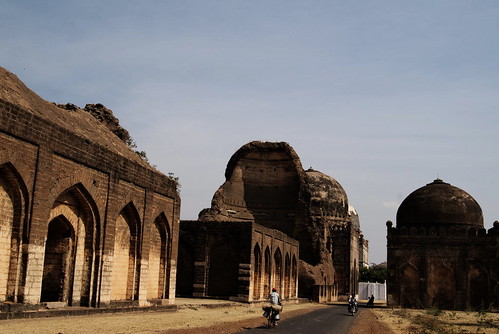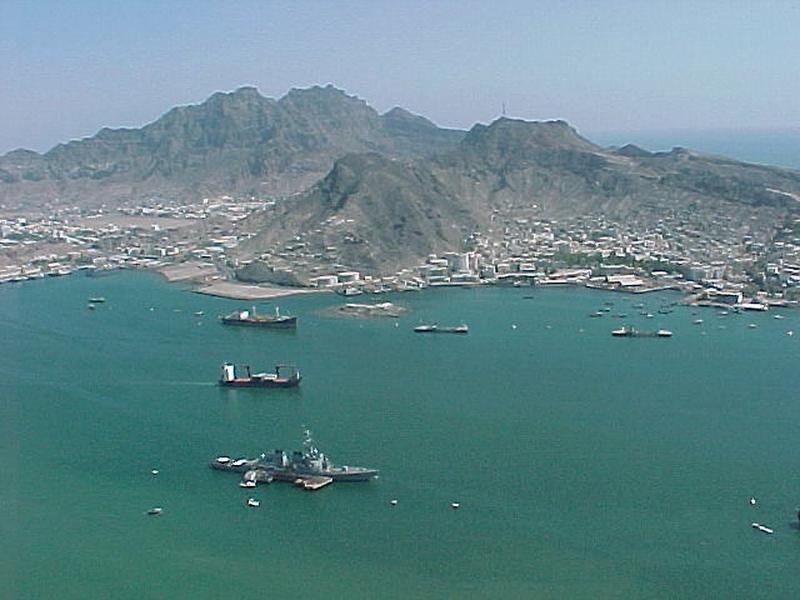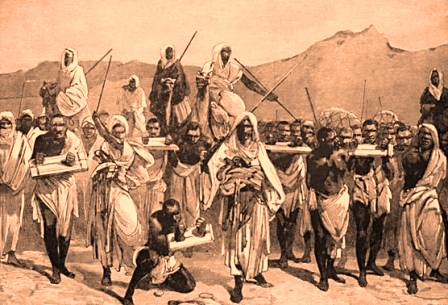I. New Islamic Empires
A. Mali in the Western Sudan--Muslim rule in the seventh century greatly stimulated increased trade along the routes that crossed the Sahara. In the centuries that followed, Islam gradually spread to the lands south of the desert.
1. Muslim advances--Muslim Berbers invading out of the desert in 1076 caused the collapse of Ghana, the empire that preceded Mali in the western Sudan, but their conquest did little to spread Islam. To the east, the Muslim attacks that destroyed the Christian Nubian kingdoms on the upper Nile in the late 13th century opened the area to Muslim influence, but Christian Ethiopia successfully withstood Muslim advances. Instead, Islam's spread south usually followed a pattern of gradual and peaceful conversion. The expansion of commercial interests, coupled with Islam's spiritual appeal to many Africans, were the major forces behind this.
2. Sundiata--a leader of the Malinke people, whose army defeated King Sumanguru's army from Takrur for control of regional and trans-Saharan trade routes. Mali, as the new kingdom was known, controlled not only the nearby trade routes, but the core trading area surrounding the upper Niger River--including the rich gold fields at the headwaters of the river.
3. Mansa Musa--was one of Sundiata's successors. During his pilgrimage to Mecca in 1324-1325, he distributed so much gold that the value of that metal was depressed for years afterward. He traveled to Mecca with a huge retinue, including his principal wife, five hundred of her ladies in waiting, as many as sixty thousand porters and a vast caravan of camels, with 500 hundred slaves who carried golden staffs.
4. Ibn Battuta in Mali--Ibn Battuta wrote vivid accounts of the countries he visited during his extensive travels; his accounts are perhaps the best source for an idea of what life was like in Muslim countries during this time. He visited Mali during the reign of Mansa Suleiman, and reported that "complete and general safety" prevailed in the vast territory he ruled.
5. The Fall of Mali--Two centuries after its founding, Mali began to disintegrate. Mansa Suleiman's successors could not prevent rebellions breaking out among the diverse peoples subject to Malinke rule, and other groups outside this sphere of influence were drawn to attack to attempt to gain some of the wealth of the kingdom. By 1500, the rulers of Mali ruled only little more than the Malinke heartland.
B. The Delhi Sultanate in India--after losing the defensive unity of the Gupta Empire, the divided states of northwest India fell prey to raids by Afghan warlords by the early 11th century. In the last decades of the 12th century, a Turkish dynasty armed with powerful crossbows captured the Indian cities of Lahore and Dehli.
1. Sultan Iltutmish--Between 1206 and 1236, Muslim invaders extended their rule over the Hindu princes and chiefs in much of northern India. Sultan Iltutmish consolidated this conquest in a series of military expeditions that made his realm the largest in India. He secured official recognition of the Delhi Sultanate as a Muslim state from the caliph of Baghdad, and began the transformation of Muslims from brutal conquerors to somewhat more benign rulers
2. Raiziya, a Female Sultan--Iltutmish astonished his ministers by attempting to pass over his sons and designate his daughter Raziya his successor. Only after her elder brother proved completely inept did the Turkish chiefs accede to her father's wishes--although that was only for four years, even though she proved a capable ruler.
3. Annexation of Gujarat--After a half-century of stagnation and rebellion after the establishment of the Delhi Sultanate, Sultan Ala-ud-din Khalji increased the control over the outlying provinces. Successful frontier raids and high taxes kept his treasury full, wage and price controls kept down the costs of maintaining a huge army, and a network of spies stifled intrigue.
4. Muslim and Hindus--A small majority in a giant land, the Turkish rulers relied on terror to keep their subjects submissive, on harsh military reprisals to put down rebellion, and on pillage and high taxes to sustain the ruling elite in luxury and power--none of which endeared them to those they conquered.
5. South Indian Kingdoms--Personal and religious rivalries within the Muslim elite, along with Hindu discontent, threatened the Delhi Sultanate whenever it showed weakness, and finally hastened its end. In the mid-14th century, Muslim nobles established the independent Bahmani kingdom on the Deccan Plateau. To resist further Muslim incursions southward, the Hindu states of south India united to form the Vijayanager Empire--although they cooperated with the Bahamani rulers when it suited them, and the Bahamani's incorporated Hindu's into their ruling clique.
6. Timur Sacks Delhi--By 1351, when all of south India had cast off Delhi's rule, northern India rose in rebellion. In the east, Bengal broke away from the sultanate in 1338, and became the center of the mystical Sufi tradition of Islam; Gujarat regained its independence by 1390. In 1398, the disorder in Delhi led the Turko-Mongol ruler Timur to attack Delhi; when his army finally withdrew a year later, they left with great quantities of loot and tens of thousands of slaves, and the largest city in southern Asia lay in ruins.
II. Indian Ocean Trade
A. Monsoon Mariners
1. Trade Goods--The prosperity of Islamic and Mongol empires in Asia, cities in Europe, and new kingdoms in Africa and Southeast Asia stimulated and contributed to the vitality of the Indian Ocean network. The demand for luxuries--precious metals and jewels, rare spices, fine textiles, and other manufactures--rose. Larger ships made shipments of bulk cargoes profitable. The great distances necessary to cover help to divide this trade into two legs: from the Middle East across the Arabian Sea to India and from India across the Bay of Bengal to Southeast Asia.
2. Dhows--relatively small watercraft manufactured on the Malabar Coast in southwestern India dominated trade on the Arabian Sea--although they grew from 100 ton capacity in 1200 to 400 tons by 1500. On a typical expedition, a dhow might sail west from India to Arabia and Africa on the northeast monsoon winds (December to March) and return on the southwest monsoons (April to August)
3. Chinese Junks--by far the largest ships plying the oceans of the world; junks could accommodate 100 passenger cabins and a cargo of over 1,000 tons--and the largest carried a crew of over 1,000. Junks dominated China's foreign shipping to Southeast Asia and India, but the Chinese did not control all of the junks that plied these waters. During the 15th century, similar vessels came out of shipyards in Bengal and Southeast Asia sailed by local crews.
4. From Africa to China--Decentralized and cooperative commercial interests, rather than political authorities, connected the several regions that participated in the Indian Ocean trade. The Swahili Coast supplied gold from the interior of Africa, ports around the Arabian peninsula supplies horses and goods from the northern parts of the Middle East, the Mediterranean, and eastern Europe. Merchants in the cities of coastal India received goods from east and west, sold some locally, passed others along, and added Indian goods to the trade. The Straits of Malacca, between the eastern end of the Indian Ocean and the South China Sea, provided a meeting point fro the trade from Southeast Asia, China, and the Indian Ocean. In each region, certain ports functioned as giant emporia, consolidating goods from smaller ports and inland areas for transport across the seas.
B. Africa: The Swahili Coast and Zimbabwe--Trade expanded steadily along the East African coast from about 1250, giving rise to between thirty and forty separate city-states by 1500. After 1200, masonry buildings replaced mud and thatch buildings, and archaeological findings indicate and extensive trade network had been built.
1. Ibn Battuta in Kilwa--Sometime after Ibn Battuta's visit to Mogadishu in 1331, the more southerly city of Kilwa surpassed it as the Swahili Coasts most important commercial center--because by then it was exporting more than a ton of gold each year from mines even further south.
2. Great Zimbabwe--the city now known to us as Great Zimbabwe controlled these gold mines, and used the profits generated from the gold trade to build a grand city, but scholars now suspect that the depletion of firewood and the overgrazing of cattle hastened the empire's collapse in the 15th century.
C. Arabia: Aden and the Red Sea
1. Ibn Battuta in Aden--The city of Aden had a double advantage in the Indian Ocean trade. Monsoon winds brought enough rainfall to supply drinking water for a large population and to grow grain for export, and its location made in a convenient stopover for trade with India, the Persian Gulf, East Africa, and Egypt. Ibn Battuta observed that these conditions contributed to fabulous wealth for a number of merchants
2. Yemen and Ethiopia--Common commercial interests generally promoted good relations among the different religions and cultures in the region, although sometimes these differences created periods of friction.
D. India: Gujarat and the Malabar Coast--The state of Gujarat in western India prospered from the expanding trade of the Arabian Sean and the rise of the Delhi Sultanate. Blessed with a rich agricultural hinterland and a long coastline, Gujarat attracted new trade after the Mongol destruction of Baghdad in 1258 disrupted the northern land routes. After the initial violence of its forced incorporation into the Delhi Sultanate in 1298, Gujarat prospered from increased trade with Delhi's ruling class. Independent again after 1390, the Muslim rulers of Gujarat extended their control over neighboring Hindu states and regained their preeminent position in the Indian Ocean trade.
1. Maritime Trade--Gujaratis exported cotton textiles and indigo to the Middle East and Europe, in return for gold and silver. They also shipped cotton cloth, carnelian beads, and foodstuffs to the Swahili Coast in exchange for ebony, slaves, ivory, and gold. During the 15th century, traders expanded eastward to the Strait of Malacca. These Gujarati merchants helped spread the Islamic faith among East Indian traders, some of whom even imported carved gravestones from Gujarat.
2. Cambay and Calicut--Later observers compared the Gujarati city of Cambay with cities in Flanders and northern Italy in the scale, artisanry, and diversity of its textile industries. Cotton, linen, and silk cloth, along with carpets and quilts, found their way to Europe, Africa, the Middle East, and Southeast Asia. At the height of its prosperity, its well-laid out streets and open places boasted fine stone housed with tiled roofs. Although Muslims controlled most of the overseas trade, Hindu merchants profited so much from related commercial activities that their wealth and luxurious lives became the envy of other Indians. Other cities along the west coast like Calicut also shared in the wealth.
D. Southeast Asia--At the eastern end of the Indian Ocean, the Strait of Malacca between the Malay Peninsula and the island of Sumatra provided the principle passage into the South China Sea. As trade increased in the fourteenth and fifteenth centuries, this commercial choke point became the site of political rivalry.
1. Kingdom of Majapahit--The mainland Kingdom of Siam controlled most of the upper Malay Peninsula, while the Java-based Kingdom of Majaphahit extended its domination over the lower Malay Peninsula and much of Sumatra. They could not control a band of Chinese pirates based in Palembang, however, that preyed on ships sailing through the strait. In 1407, a fleet from China smashed the pirates' power and took their chief back to China for trial. Majahpahit, weakened by internal struggles, could not take advantage of China's intervention, however.
2. The Rise of Malacca--The beneficiary of China's intervention was the newer port of Malacca, which dominated the narrowest part of the strait. Princes in Malacca made a series of strategic alliances, which resulted in the visit of the imperial fleet from China, and with Muslim traders fro Gujarat and elsewhere. Malacca served as both a meeting point and an emporium of exotic trade goods
III. Social and Cultural Change
A. Architecture, Learning, and Religion
1. Temples and Mosques--Social and cultural changes typically affected cities more than rural areas. As Ibn Battuta and other travelers observed, wealthy merchants and ruling elites spent lavishly on mansions, palaces, and places of worship. Most places of worship surviving from this period blended older traditions and new influences.
2. Spread of Literacy--Mosques, churches, and temples were centers of education as well as prayer. Muslims promoted literacy among their sons (and sometimes their daughters) so they could read the sacred texts.
3. Timbuktu--a city on the Niger River in the modern country of Mali. The city was founded by the Tuareg as a seasonal camp sometime after 1000. As part of the Mali Empire, Timbuktu became a major terminus of the trans-Saharan trade and a center of Islamic learning, with over 150 schools teaching the Quran, and leading clerics taught advanced classes in private homes.
5. End of Indian Buddhism--In India, Muslim invasions eliminated the last strongholds of long-declining Buddhism, including the great Buddhist center of study at Nalanda in Hihar in 1196. Manuscripts were burned, and thousands of monks killed or driven into exile in Nepal and Tibet. Islam emerged as the second most important religion in India, behind Hindusim--and Islam displaced Hinduism in most of maritime Southeast Asia.
B. Social and Gender Distinctions--the growth of slavery accompanied the rising prosperity of the elites.
1. The Slave Trade--According to modern estimates, between 1200 and 1500 Saharan and Red Sea traders bought approximately 2.5 millions slaves from sub-Saharan Africa. Because of the abundance of "free" labor, however, the purpose of these slaves was to serve as house servants, and often as soldiers in various armies--although some were also employed in occupations like mining, which few free workers desired to engage in.
2. Status of Women--in much of the region, the status of women improved somewhat. In India, the sati remained a strongly approved social custom, but as Ibn Battuta made clear, it was an option that could be resisted more successfully than in the past. Indian parents still gave their daughters in marriage before puberty, but the marriage was not consumated until the young woman was ready.
3. Women's Activities--Besides child rearing, women were engaged with food preparation--including brewing, when not prohibited by religious practice. Women were also largely responsible for much of the farm work, including especially planting and harvesting crops
IV. Conclusion--Tropical Africa and Asia contained 40 percent of the world's population and over a quarter of its habitable land in 1500. Between 1200 and 1500, commercial, political, and cultural currents drew the region's peoples closer together, and the Indian Ocean became the world's most important and richest trading area. Trade and empire followed closely the enlargement of Islam's presence and the accompanying diversification of Islamic customs.
Yet many social and cultural practices remained stable. Most tropical Africans and Asians never ventured far outside the rural communities where their families had lived for generations. Their lives followed the patterns of the seasons, the cycle of religious rituals and festivals, and the stages from childhood to adulthood.














this is the most useless bullshit and does nothing for me you nigger
ReplyDeleteNot very bright, huh, Mrtrolol66? Not able to follow the info? Thanks Gregory. Reading this was equivalent to having a cliff note covering my chapter.
Delete